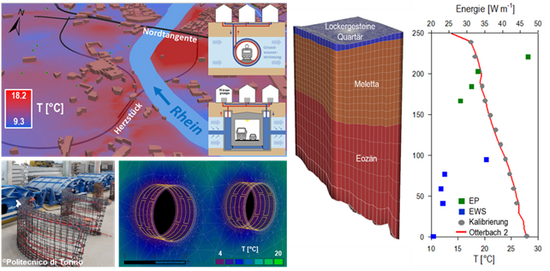Thermal potential of urban tunnel infrastructure
SFOE-funded feasibility study "ThePoTun"
Within the framework of "ThePoTun", AUG evaluated concepts for coordinated efficient thermal use of tunnel structures for the generation of renewable thermal energy in the urban area of Basel. Another focus was also on the evaluation of different strategies for combination with ATES (Aquifer Thermal Energy Storage) systems for seasonal thermal energy storage in solid rock.
The results show that thermal activation of tunnel absorber systems (TAS) is most efficient in sections of the planned "Herzstück" urban rail tunnel passes through groundwater-saturated unconsolidated rock. The thermal use of water circulating in culvert systems proved to be advantageous only in heating mode and for sections where the highway tunnel runs perpendicular to the regional groundwater flow and comparatively high groundwater temperatures exist. The cooling down of groundwater resources and tunnel air conditioning can be a solution for local environmentally relevant adaptation measures of large construction projects. Thus, it was shown that against the background of climate changes, the operation of TAS is a possible adaptation strategy to counter the temperature development of urban groundwater resources.
An important result of the feasibility study is also that the potential of thermal utilization of tunnel infrastructures was considered in the current subdirective plan for energy for the canton of Basel-Stadt and that aspects of thermal influence and utilization are being clarified for the highway "Rhine Tunnel" currently in the planning stage.
The measurements of the tunnel internal air temperature of the “Nordtangente” carried out within the framework of ThePoTun also currently serve as a reference for an estimation of the thermal influence of the planned highway "Rhine Tunnel". This also shows again the importance of corresponding data bases and knowledge of the thermal influence of underground structures. Especially against the background that in Switzerland infrastructure structures are increasingly realized in the subsurface, which affect subsurface resources both quantitatively (groundwater flow) and qualitatively (groundwater temperatures).
Commissioned by: Swiss Federal Office of Energy (SFOE)
Project duration: 2017 – 2020
AUG: Jannis Epting, Peter Huggenberger

Top left: Groundwater temperatures and urban subsurface structures, including thermal use via "passive" energy absorbers for commuter rail tunnels and "active" thermal use of groundwater in culvert systems. Bottom left: Use of ENERTUN© heat absorbers in the Turin Metro tunnel structure (Politecnico di Torino) and implementation for local 3D heat transport modeling. Right: Geometries of the ATES heat transport model as well as temperature depth profile of the geothermal exploration well Otterbach 2 in connection with the results of the simulations of the energy potential of BHE (borehole heat exchangers) and EP (energy piles).
Quick Links
Social Media
